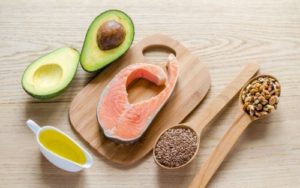In health and fitness, there’s no bigger topic than good fats versus bad fats.
Fat used to be a four-letter word. The goal was to cut out as much fat as possible. Eventually, cutting out fat didn’t make people healthier. It’s probably because the good fats were cut out as well as the bad fats. Everyone needs to get used to the idea of good fats and bad fats.
Fat is necessary in the diet. Fat is a major source of energy. It helps absorb the fat-soluble vitamins A, D, E, and K in the body. Fats help build cell membranes and are essential for blood clotting, muscle movement and inflammation. Fat plays a vital role in proper health and nutrition.
Bad Fats
Saturated fat is a type of fat containing a high proportion of fatty acids. Saturated fat raises the level of cholesterol in your blood and can increase your risk of heart disease, stroke, and diabetes. Saturated fat is found in high-fat meats and dairy products. Sources of saturated fat are the fatty cuts of beef, pork, and lamb. Dark chicken meat and skin are also high in saturated fat. Whole milk, butter, cheese, and ice cream are sources of saturated fat.
The worst of the bad fats is known as trans fats. Trans fats are a byproduct of the process for turning heathy vegetable oils into solids for food processing. You’ll find it on the ingredients list on food labels as “partially hydrogenated oil.” Trans fats have been used in solid margarines and vegetable shortening as well as cookies, pastries, and fast food french fries.
Trans fats have no known health benefits. They increase the amount of harmful LDL cholesterol in the bloodstream and reduce the beneficial HDL cholesterol. Consuming even small amounts of trans fats can be harmful to your health. If 2% of your daily caloric intake comes from trans fats you increase your risk of heart disease by 23% according to the Harvard School of Public Health.
Good Fats
Monounsaturated fats and polyunsaturated fats are considered the good fats and should be included in your diet in moderation. Good fats mainly come from vegetables, nuts, seeds, and fish.
Research shows eating foods with monounsaturated fat can improve your blood cholesterol level and decrease your risk of cardiovascular disease. Sources of monounsaturated fats are olive oil, peanut oil, canola oil, avocados, and most nuts.
Polyunsaturated fats are essential fats required for normal body functions. Your body can’t make them so you must get them from food. Sources of polyunsaturated fats are walnuts, sunflower seeds, flax seeds or flax oil, fish, corn oil, soybean oil, safflower oil.
Omega-3 fatty acid is a certain type of polyunsaturated fat that’s known to be good for your heart. Omega-3’s decrease the risk of heart disease and may help lower blood pressure. Sources of omega-3 fatty acids are salmon, herring, sardines and trout.
Make good choices with your foods and lean towards the good fats. All fats should be eaten in moderation as they are higher in calories per gram than proteins and carbohydrates.

